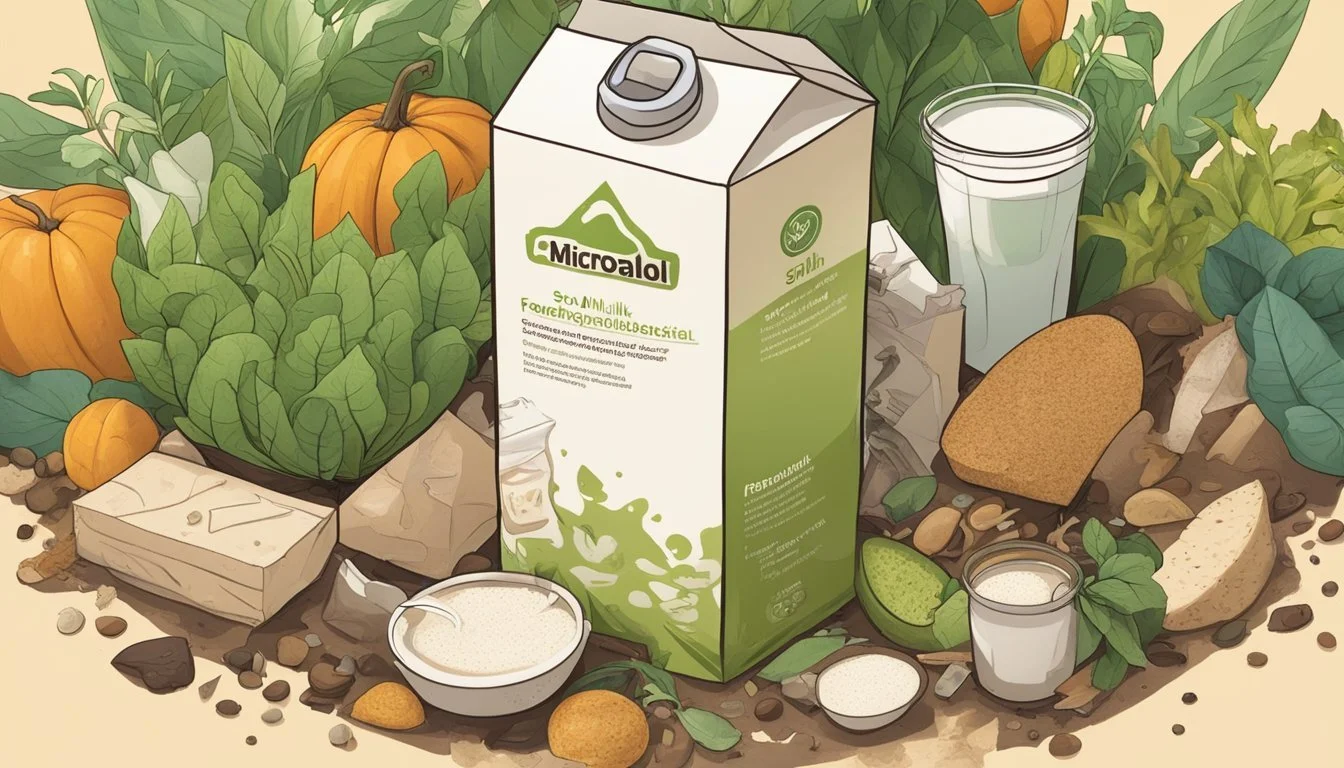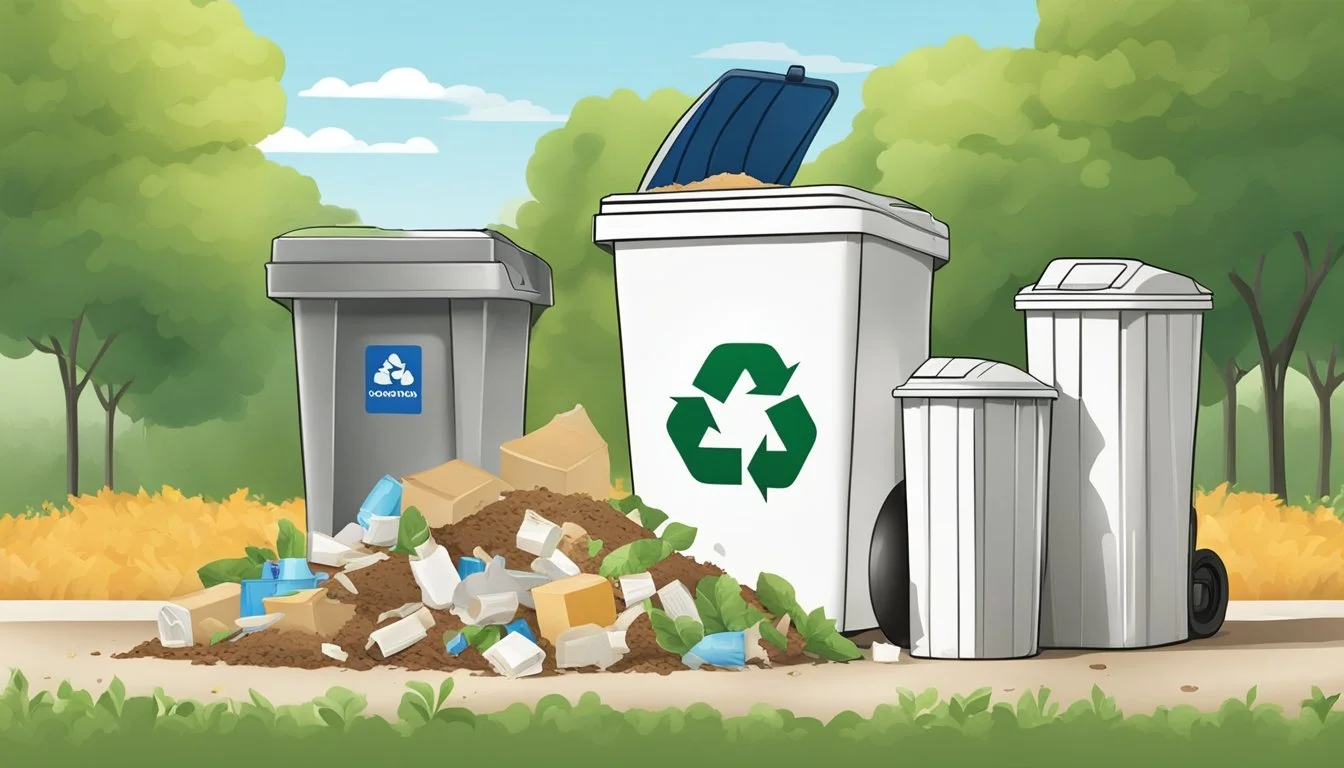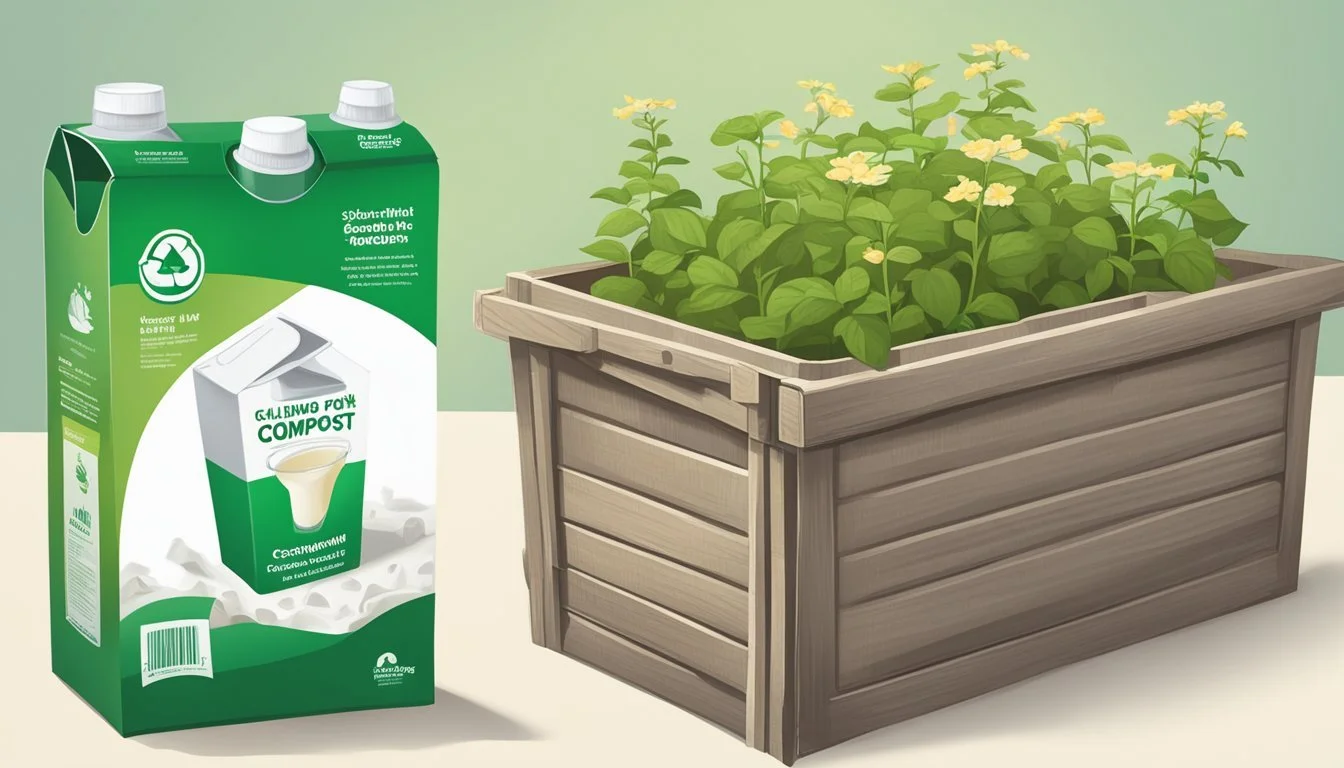Can You Compost Soy Milk Cartons?
Insights on Recycling Plant-Based Packaging
Composting is a process that turns organic waste into nutrient-rich soil, but not all materials are suitable for this eco-friendly practice. Soy milk cartons pose a particular challenge to compost enthusiasts and environmentalists alike. The main component of these cartons is paper, which in theory is compostable, but there's an added complexity due to the thin layer of plastic, often polyethylene, used to line the cartons to preserve freshness and prevent leaks.
The presence of this plastic lining means soy milk cartons cannot be composted through conventional means as readily as other paper products. The thin layer is resistant to the microbial activity that breaks down organic matter in a compost pile. Additionally, cartons designed to be shelf-stable may include an aluminum layer, which further complicates their ability to be broken down naturally.
Given their composition, these cartons require special processing to separate the paper from the lining materials, which is beyond the capability of most typical home compost systems. Some municipal composting facilities might have the infrastructure to handle such composite materials, but they are not widely available. Consumers interested in disposing of their cartons in an environmentally responsible way should check with their local waste management services to understand the available recycling or composting options.
Understanding Soy Milk Cartons
When considering soy milk cartons for composting, it is crucial to understand their composition and types. They typically consist of multiple layers to preserve the product's freshness and are categorized mainly by their structural design.
Components of Soy Milk Cartons
Soy milk cartons are composed of a combination of paperboard, plastic, and sometimes aluminum. These multiple layers serve specific purposes:
Paperboard: The primary material, provides structure and stability.
Plastic Coating: Typically polyethylene, it waterproofs the carton and retains liquid content.
Aluminum: Found in aseptic cartons, it offers an oxygen barrier to maintain the product's shelf life without refrigeration.
The composite nature affects the carton's compostability and recyclability.
Types of Milk Cartons
Milk cartons used for soy milk can be broadly classified into two types:
Gable Top: These are often used for refrigerated products and are primarily made of paperboard with a thin layer of plastic.
Features Gable Top Material Paperboard Coating Thin plastic layer Refrigeration Required
Aseptic (Tetra Pak): These cartons contain additional layers, including aluminum, to allow for shelf-stable storage without refrigeration.
Features Aseptic (Tetra Pak) Material Paperboard Coating Plastic and Aluminum Refrigeration Not required
Each type of carton has distinct recycling and composting requirements due to their materials and construction.
Composting Fundamentals
In exploring whether soy milk cartons can be composted, it is essential to understand the basics of composting --- from its definition to its ecological benefits and the process involved.
What is Composting?
Composting is the natural breakdown of organic materials into a nutrient-rich soil amendment known as compost. This transformation is fueled by microbial activity in the right conditions of moisture, carbon, nitrogen, and oxygen. It involves placing organic waste in a compost bin where it decomposes over time.
Benefits of Composting
Composting has several environmental benefits:
Soil Health: It enriches the soil, helps retain moisture, and suppresses plant diseases and pests.
Waste Reduction: Diverts organic waste from landfills, reducing methane emissions.
Resource Efficiency: Recycles organic materials, returning nutrients back to the soil.
Composting Process Explained
The composting system is an intricate interaction of organic matter, microorganisms, and environmental factors:
Balance of Materials: A successful compost pile maintains a balance between carbon-rich materials (browns) like dried leaves, and nitrogen-rich materials (greens) such as food scraps.
Microbial Activity: Microorganisms break down organic matter, and this process is facilitated by maintaining adequate moisture and aeration.
Compost Bin: An enclosed space where composting occurs, protecting the pile while providing containment.
By understanding these fundamentals, one can better gauge which materials are suitable for composting, including soy milk cartons and their specific composition.
Compostability of Materials
Understanding the distinction between biodegradability and compostability is essential when examining the composting potential of soy milk cartons and other packaging materials.
Biodegradability vs. Compostability
Biodegradability refers to the ability of a material to break down into natural elements, carbon dioxide, and water vapor by the action of microorganisms. Compostability, on the other hand, is a subset of biodegradability, where materials decompose into nutrient-rich soil amendments under specific composting conditions. Not all biodegradable materials are compostable as some may leave behind toxic residue or take an excessively long time to decompose.
Common Compostable Products
Products commonly considered compostable include:
Uncoated paper
Certain types of bioplastics
Food waste
Yard trimmings
Compostable products should decay within a pre-determined time frame, typically 90 days, without leaving any toxic residue or fragments that are distinguishable from the compost.
Challenges with Composting Packaging Materials
Composting packaging materials, such as soy milk cartons, is challenging due to their composition. Such cartons often combine paper with a thin layer of plastic or, in shelf-stable cartons, an aluminum lining. These materials impede the decomposition process and can result in a final compost with plastic fragments, thereby reducing the quality of the compost. The process to separate these layers is intricate and not always feasible in traditional composting facilities. Moreover, bioplastics used in some packaging require industrial composting conditions that are not commonly available to the average consumer.
Composting Milk Cartons
When considering the compostability of milk cartons, one must differentiate between aseptic cartons and traditional paperboard cartons due to the distinctions in materials and recyclability.
Aseptic Cartons and Composting
Aseptic cartons, commonly used for soy milk and other shelf-stable beverages, are challenging to compost. They are lined with aluminum and a layer of low-density polyethylene (LDPE) to preserve the contents and prevent leakage. This complex material mix does not decompose easily in a typical composting environment, as the breakdown of aluminum and LDPE is not facilitated by standard composting processes. Therefore, aseptic cartons should generally be redirected toward recycling streams specifically equipped to handle multi-material packaging.
Paperboard Cartons in Compost
Paper milk cartons, on the other hand, are primarily made from high-grade paperboard. However, they too are often coated with low-density polyethylene to improve liquid containment. This coating impacts the composting process, as the natural microbial activity cannot effectively break down the synthetic polymer. While the paper component may decompose over time, the LDPE may persist, making these cartons less suitable for composting. Optimally, one should look for designated composting facilities capable of processing these materials or focus on recycling paperboard cartons if local waste management systems permit.
Recycling vs. Composting
In the context of sustainability, recycling and composting are two methods of waste management that apply to materials such as soy milk cartons. Each has its distinct process and advantages, particularly when addressing the recyclability of materials and their potential afterlife.
Defining Recycling
Recycling is the process of collecting and processing materials that would otherwise be discarded as trash and turning them into new products. Recycling aims to reduce the consumption of fresh raw materials, curb energy usage, decrease air and water pollution, lower greenhouse gas emissions, and prevent useful materials from ending up in landfills.
Recycling Process
The recycling process for materials like milk cartons involves several steps. Initially, milk cartons are collected through curbside pickup programs or drop-off centers. These cartons are then transported to a recycling facility where they are sorted, cleaned, and reprocessed into recycled materials that can be used in manufacturing new products. It is significant to note that carton recycling has specifics in terms of the recycling guidelines; for instance, milk cartons often need to be emptied and rinsed to prevent contamination.
Collection: Milk cartons are collected from homes, businesses, or designated collection centers.
Sorting: Materials are sorted by type and category.
Processing: Cartons are cleaned and broken down into a form that can be used to create new products.
Advantages of Recycling Over Composting
Recycling milk cartons has certain advantages over composting. Recycled cartons can be transformed into a variety of products, effectively diverting them from the landfill and conserving resources. The process of recycling tends to be more controlled and can handle a broader range of materials compared to composting. Whereas composting is limited to organic waste that can biodegrade, recycling accommodates a diverse array of items, including those that do not break down naturally, such as plastic-coated milk cartons. Recycling also has the advantage of:
Reducing landfill waste: By providing an alternative use for recyclable materials.
Conserving resources: Saves raw materials and energy required to produce new products.
Recyclability: Allows the continuous repurposing of materials, leading to a circular economy.
Practical Aspects of Carton Disposal
Disposing of soy milk cartons involves specific steps to ensure they are recycled properly. The success of carton recycling hinges on appropriate separation and preparation before the cartons reach the recycling facility.
Proper Separation and Sorting
Separation is vital in the recycling process of soy milk cartons. Consumers should separate these cartons from other recyclables due to their composite structure, which often includes paper, plastic, and sometimes aluminum. Sorting should be guided by local recycling rules, as some facilities may require cartons to be disposed of with plastics, while others with paper products.
Paper Stream: If local facilities process cartons with the paper stream, individuals should place them with paper recyclables.
Plastic Stream: If the facility treats cartons as plastics, they should go into the plastic recycling bin.
One must check with their local recycling program to identify the correct stream for soy milk carton disposal.
Rinsing and Preparing Cartons
Before recycling, soy milk cartons should be thoroughly rinsed to remove any residue. This step is crucial for two reasons:
It prevents contamination of other recyclables.
It increases the likelihood that the carton will be recycled.
Cartons should be emptied completely and rinsed with water. Once cleaned, they can be placed in the appropriate recycling bin as per the local guidelines. It's essential that the cartons are dry before disposal to avoid the growth of mold, which can degrade the quality of recyclable materials.
Alternative Uses for Soy Milk Cartons
While composting soy milk cartons may not be readily feasible due to their plastic coatings, there are numerous ways these containers can be repurposed. These alternative uses provide practical and creative methods to extend the life of soy milk cartons beyond their original purpose.
Creative Reuse Ideas
Planters: Soy milk cartons can be transformed into planters for small herbs and flowers. By cutting the top off and poking a few drainage holes in the bottom, one creates an ideal environment for starting a kitchen garden.
Herbs: Cartons are perfect for growing basil, cilantro, or chives.
Flowers: Small flowers like marigolds or pansies can thrive in these makeshift pots.
Craft Projects: Soy milk cartons can also be the base material for a variety of craft projects, rendering them excellent tools for educational activities.
Bird Feeders: Paint and decorate a carton, cut openings, and fill with bird seeds.
Organizers: Cartons can be cut and folded to create desk organizers for pens and small office supplies.
DIY Projects with Milk Cartons
Soy milk cartons offer a durable material that can be easily cut, folded, and transformed for DIY projects.
Lanterns: One can create beautiful lanterns by cutting intricate patterns into the sides of the cartons, painting them, and placing lights inside.
Wallets or Purses: Ingenious crafters can fashion the sturdy material into small wallets or purses, often with the original carton graphics as a unique design element.
Overall, soy milk cartons provide versatile materials that can inspire both practical and artistic reuse options, effectively reducing waste through creative repurposing.
Environmental Considerations
The section explores the impact of soy milk cartons on landfills and their relationship with sustainability. It emphasizes the need to understand how these cartons interact with natural resources and their life cycle in order to make informed decisions regarding their disposal.
Impact of Cartons on Landfills
Soy milk cartons, if not properly disposed of, end up in landfills where they contribute to the ever-growing waste problem. In landfills, these cartons take a significant amount of time to break down, potentially leading to the release of methane, a potent greenhouse gas. Additionally, the space that cartons occupy in landfills is considerable, given the volume produced annually. The majority of cartons are made from paper, which is a renewable resource, but they also contain a thin layer of polyethylene. The decomposition of this plastic component can take years, thus slowing the process of the carton becoming part of the soil again.
Sustainability and Carton Usage
Soy milk cartons present a challenge when it comes to sustainability due to the materials used in their construction:
Paper: A renewable resource but requires energy and fossil fuel input for production and transportation.
Polyethylene: A plastic layer that is not a renewable resource and is derived from fossil fuels.
Reducing the use of fossil fuels in the production and the recycling process of these cartons is pivotal for enhancing their sustainability. By choosing to recycle or compost cartons, consumers can decrease the demand for new natural resources and reduce the reliance on fossil fuels. However, the efficacy of composting is limited by the fact that the plastic components do not break down as easily as the paper, making it essential for consumers to follow local guidelines on composting and recycling to ensure the proper handling of these materials.
Local Recycling and Composting Guidelines
Within the realm of responsible waste management, understanding the intricacies of local recycling and composting rules is paramount. Determining whether soy milk cartons are recyclable or compostable can depend heavily on these regulations.
Navigating Local Recycling Programs
Each municipality or region has its own unique set of recycling guidelines, often influenced by available processing facilities. The Carton Council plays a significant role in aiding local councils to embrace carton recycling, with a primary focus on curbside recycling programs. To find out if soy milk cartons can be recycled in your area, one should:
Visit the Carton Council's website and use the provided locator tool.
Contact local waste management authorities directly for specific instructions.
Ensure that cartons are emptied and rinsed before recycling.
Some facilities may not accept cartons for recycling because they consist of a combination of materials, typically paper with a thin layer of polyethylene. These cartons may require a specialized paper mill that can process them into paper pulp and separate the plastic.
Participation in Community Composting
Community composting initiatives are increasingly common and may have different guidelines than municipal composting facilities. When considering composting soy milk cartons, keep in mind:
Verify with the community composting program whether they accept cartons with plastic linings.
Understand that cartons lined with a plastic or aluminum barrier are generally not suitable for composting due to the extended time required to decompose.
By engaging with local resources and adhering to the provided guidelines, one can contribute to a sustainable approach to waste disposal.
Limitations and Controversial Aspects
When considering the compostability of soy milk cartons, it is crucial to address the inherent complications that can arise during the process. These issues largely pertain to the materials used in cartons and the conditions needed for composting them.
Contaminants and Composting
Soy milk cartons often have a layer of plastic or aluminum, which complicates their decomposition in compost. The following points outline specific concerns:
Plastic Coating: A common component in the cartons is polyethylene, which does not decompose easily. This plastic layer obstructs the breakdown process that is essential in composting.
Aluminum Lining: Some cartons contain an aluminum lining for shelf stability, which is also not biodegradable and can remain in the compost for an extended period.
Pathogens: While not directly related to the carton materials, composting dairy or plant-based milk residues may lead to pathogen presence if the compost does not reach a sufficiently high temperature to kill harmful bacteria.
Odor Production: Improper composting of organic residue in the cartons can lead to the creation of undesirable odors as anaerobic decomposition occurs.
Anaerobic Decomposition: If cartons are not broken down properly or composted in an oxygen-poor environment, they can contribute to anaerobic decomposition, which is not desired in composting because it slows down the process and can lead to a release of methane, a potent greenhouse gas.
Leachate: This liquid by-product of the composting process can contain contaminants from the milk carton's plastic and aluminum. If not managed correctly, leachate can seep into the ground, potentially harming the surrounding ecosystem.










